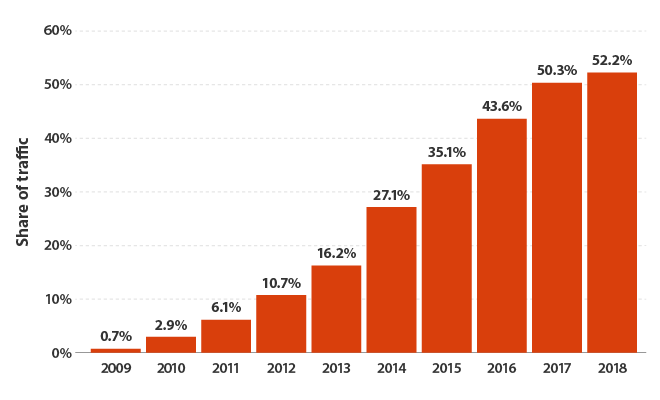Mobile marketing for restaurants
In order to build a successful modern restaurant business, you need to reach guests where they are. People spend more than 3.5 hours daily on mobile devices. In addition to using devices to get news and talk to friends, most consumers interact with their favorite brands through a mobile device. For restaurants this means that potential guests are looking for restaurant reviews, the ability to order online, and to make reservations.
So, how can a restaurant integrate mobile marketing into their overall marketing strategy?
Build a responsive website
More and more consumers report using their mobile device as their primary platform for accessing the Internet, and for every minute spent browsing the web, an additional 6 minutes are spent on apps.
While that may sound like you should put all your effort into app development, consider that the majority of that time is spent on just one or two high-usage messenger apps, meaning the web is still the primary focus for most businesses. Since reading a website that is not mobile-friendly can turn people off your brand quickly, it’s critical that you build a responsive website. Simply put, responsive web pages resize automatically to fit the type of device used to see it, whether a large desktop screen or a small smartphone.
Percentage of all global web pages served to mobile phones from 2009 to 2018

Statista (2019)
Responsive website design does more than just impress your customers with your online guest experience. It can improve your SEO rankings because Google now crawls and assesses websites for mobile as well as desktop performance.
Templates from most of the major website builders now come with responsiveness built in. If you have a more custom setup for your site, this may be the right time to consider a refresh to bring things up-to-date.
If you fail to address your restaurant website design your other marketing efforts may not be as successful as they could be. Don’t waste your restaurant advertising activity because your site isn’t optimally designed.
Third-party listings
It’s not just your own website that you need to worry about. Your restaurant needs to be working actively to cover all the bases, wherever your potential customer is likely to be looking.
Map listings
Does your restaurant appear when you search for your cuisine type on your favorite map app? If not, you may need to update the important information like opening hours and contact details to help drive your local marketing efforts.
Local restaurant listing and review apps
Restaurants have a love-hate relationship with sites like Yelp and TripAdvisor, but whatever your personal feelings, be sure to claim your page so you can monitor and manage it.
Third-party delivery apps
If your restaurant accepts orders from one of the many delivery apps, you need to manage that profile as if it were your own site, keeping menu items up-to-date and working on your brand identity to maximize sales.
Social media apps
While not dedicated to restaurants, social media is the most popular mobile activity, so social media marketing must be part of your plan.
Does your restaurant need its own app?
With myriad avenues consumers have to search restaurants, learn about menus, and make dining decisions, you need a way to stand out. Having your own loyalty card app offers you a tool to capture their attention, control their guest experience, and increase their loyalty by offering a positive customer experience that extends beyond your four walls.
While third-party sites are great, you have limited control over them. If you’re willing and able to invest the time and money required to build and maintain your own app, you can deliver a fully branded dining experience that’s just a tap away for your customers.
Just a few of the many things you can do with your own restaurant app include:
Push notifications for special offers
Direct online ordering
Offer mobile payment
Manage your loyalty program
It takes a lot to be considered worthy enough for a place on your customer’s phone, but if you’re able to prove a valuable addition, the resulting improvement in loyalty and spend could be remarkable.
“The average person has 60-90 apps installed on their phone, using around 30 of them each month and launching 9 per day.”
techcrunch.com
Don’t forget SMS
While social media may be more prevalent, text is still the default option for many, and perhaps your most direct way into the consciousness of your customers.
Because it’s so direct, text messages should be used sparingly. However, a well-timed special offer or an invitation to try out your new menu could drive restaurant traffic. Be sure to get your customers’ opt-in to text them when you collect phone numbers. You should only message those who have signed up for SMS communications.
Rewards Network® does not provide tax, legal, or accounting advice. This material has been prepared for informational purposes only, and is not intended to provide, and should not be relied on for tax, legal, or accounting advice. You should consult your own tax, legal, and accounting advisors before engaging in any transaction.





